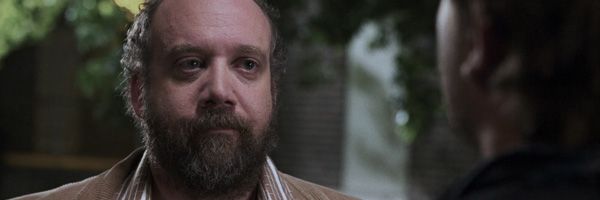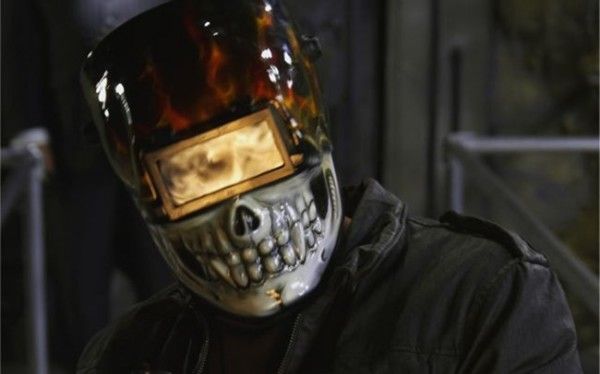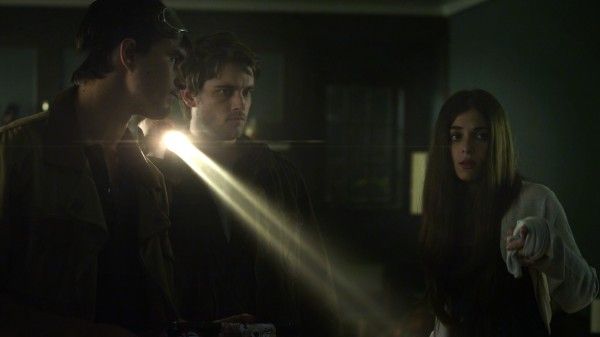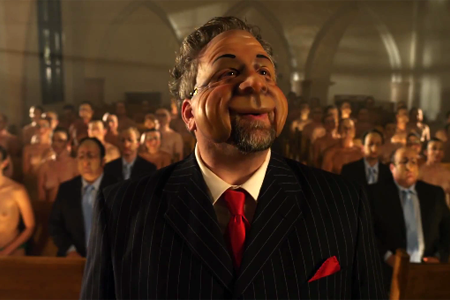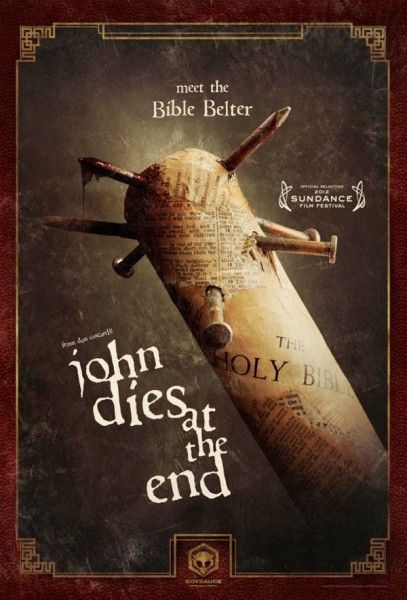Earlier this year, Don Coscarelli’s John Dies at The End had its unofficial premiere at the 2012 Sundance Film Festival, and word following that screening suggested that Coscarelli had crafted another runaway cult hit much like the director’s previous cult hit, Bubba Ho-Tep. Based on a novel of the same name by former internet presence David Wong, John Dies at The End was supposedly fast, funny, hallucinogenic, and creepy in all the ways that Coscarelli has proved himself adept at being over the years. Based on this hype, I was very much looking forward to the flick’s (now official) world premiere at the 2012 SXSW Film Festival. Did it live up to the hype? Find out below, my gentle Collider readers…
For whatever reason, whenever I hear the name “Don Coscarelli”, the first film I think of isn’t Phantasm (or any of its sequels), but Bubba Ho-Tep. That film arrived all the way back in 2002, and since then, Coscarelli’s only directing credit comes from one of the better episodes of TV’s Masters of Horror anthology series (“Incident On and Off a Mountain Road”, a title I’m still wildly in love with for reasons I’ll probably never be able to explain).
Well, now it’s 2012, and a whole new generation of film geeks will begin associating his name with a completely different—yet oddly similar—cult film, John Dies at The End. Whether or not that’s a good thing will depend entirely upon your reaction to the movie, which I’m sure will run the gamut from “Screw this mess” to “Best cult movie ever”. It really is that divisive. Unfortunately, I felt that—despite the fact that the film has some very effective moments—it failed to live up to the hype.
Coscarelli’s latest held its world premiere here at the SXSW Film Festival last night, and before the screening Coscarelli himself climbed up onstage to explain that the version of the film that screened during Sundance wasn’t the “real” one. No, that version had some “unfinished effects” (and, one gathers, a few edits that still needed to be made), and as a result could not be considered “finished”. Tonight’s version was the “final” one, and before leaving the stage, Coscarelli expressed hope that we’d all enjoy it just as much as the Sundance crowd did.
Now, I’d heard plenty about John Dies at The End following its faux-premiere at Sundance, and virtually all of it was positive. I’d heard the film was energetic, hallucinatory, aggressively weird (in all the right ways) and sometimes even flat-out creepy. I’d heard the audience ate the film up, and I’d heard it said that John Dies at The End would be the “new favorite cult movie” of a big chunk of the film-geek population. As a result, I walked into last night’s screening of the film prepared to love Coscarelli’s latest. After all, the people who’d been saying all these wildly positive things about John were people I’ve grown to trust, so what did I have to fear?
Turns out, there’s quite a bit to fear about John Dies at The End, and none of it is intentional. The overhype surrounding the film, for instance, or the truly sloppy editing showcased in several of the film’s key sequences. But wait, there’s more: the film also sports some truly embarrassing SFX work (the kind that’d make the latest SyFy epic-- Sharktopussosaur, or whatever they’re doing this week—look like something WETA produced), or the sometimes hammy performances, or the convoluted nature of the plot.
Despite everything you’ve just read in the above paragraph, I’m not prepared to call John Dies at The End a “bad” movie. Really, I’m not. Not only am I loathe to crap on Coscarelli’s work (he’s a likable guy, and has earned our respect), but I simply don’t believe that to be true. Instead, I can’t help but believe that John is—at the end of the day—a victim, of both overhype and of a director whose vision exceeded the meager budget he was boxed in by. Had Coscarelli been given another, I dunno, another $15 million to work with, there’s no doubt in my mind that the results would’ve been far more tolerable. But as it stands, John Dies at The End feels like a massive near-hit, a likely cult film that might’ve been a crossover hit if it had just figured out how to reign itself in a little bit.
Usually, this is the part where I’d unload the plot on you, but—to be perfectly honest—I’m not sure that I understood everything as presented (“as presented” is the operative phrase there). I understand that there’s this guy, David Wong (newcomer Chase Williamson, who I quite enjoyed in the film; he’s charming, kinda shaggy, and gives great deadpan), and that he and his friend, the titular John (another newcomer, Rob Mayes, who I wasn’t man-crushing on as hard once the credits rolled), are paranormal investigators of a sort. I understand that the two get mixed up in some sort of interdimensional plot involving aliens-slash-creatures-slash-insects that take over human bodies, multiply, and explode outward shortly thereafter; I understand that this is somehow tied to a new street drug (or is it?!) called “soy sauce” that allows its users to see through time, speak with the dead, and to use bratwursts as cellphones (no, really); I understand that the plot also involves a world populated by creepy doll-faced people, a girl with a fake hand, a dog that can drive a truck, Doug Jones with a helluva lot less makeup than he normally wears, and—against all odds—Paul Giamatti.
I saw these things happen, recognized them as plot points, and did my best to make sense of them, but I’d be completely full of (bleep) if I pretended to understand everything as it was presented. A few months ago, I picked up the audiobook version of Wong’s novel and listened to it in large chunks while working out at the gym, and I found the book difficult to absorb in that on-again/off-again format: I found it somewhat convoluted, hard to pick up every other day rather than reading it straight through. At least, that’s what I assumed the problem was. Now I’m wondering if it’s not just the story itself. It’s either that, or my original suspicions regarding the source material were correct…and Coscarelli failed to make these elements coalesce into a coherent film.
And yet, again, I’m finding it difficult to come right out and say that John Dies at The End is “bad”. There are moments here that played like gangbusters, sequences where everything seemed to be happening precisely as intended (and having the desired effect). A sequence involving investigative reporter Arnie Goldstone (Paul Giamatti), Wong, and the thing Wong’s got in the trunk of his car, for instance, or a truly bizarre scene where Wong gets interrogated at a police station. Over the course of the film, there are probably a dozen (let’s call them) “extended moments” where everything gels, and I loved those moments. But in-between those points, there tends to be a distressing amount of confusion.
Thing is, I think that the “confusion” is kind of the point here, and the “convoluted” nature of the story is something that Wong intended. In both the book and the film, odd detail is stacked upon odd detail, random aside follows even-weirder random aside, and that seems like a conscious choice that was made during the writing stage. For me, that style did not translate into an enjoyable film, not completely, but I can easily understand how others might fall in love with this material: there’s certainly a market out there for this kind of thing, and if John Dies at The End is being showcased in midnight screenings across the country ten years from now, I won’t be the least bit surprised-- I just won’t be in attendance.
Look, if you’re a fan of Wong’s novel, I’m sure you’re looking forward to Coscarelli’s version of things, and I’d recommend John Dies at The End to you in that event. But if you’re a newcomer to the material, I’d strongly suggest that you temper your expectations. This isn’t a film for everyone (again, this seems to be a conscious decision; Coscarelli doesn’t seem to have any interest in breaking box office records), and it might just be weird, confused, confusing, and scattershot enough to place the film in the “bad movie” category I’m stopping just short of putting it in. If you’re curious, give it a shot, but if any of this sounds like it wouldn’t be your cup of tea, I’d think long and hard before tossing down your $10 for a ticket.
Beware the overhype, my friends. Had I walked into this one without knowing a thing, I might’ve appreciated it more for what it is, rather than for what other people claimed it to be.
My grade? C+

